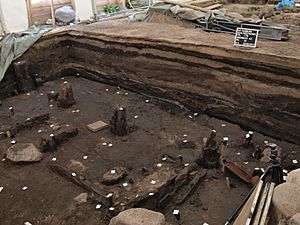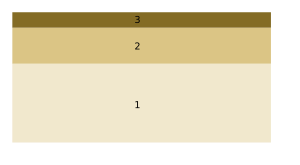Relative dating facts for kids
Relative dating is a way to figure out the order of past events without knowing their exact age. Think of it like putting events in a timeline: you know what happened first, second, and third, but not the exact year or day.
Scientists, especially geologists and archaeologists, use clues from the environment. They look at things like rocks, fossils, and layers of soil. Before we had modern tools like radiometric dating (which tells us exact ages), relative dating was the main way to understand Earth's history. Even today, it's still a very useful method!
Contents
What is Relative Dating?
Relative dating helps us understand which events happened before others. It doesn't tell us if something is 100 years old or 100 million years old. Instead, it tells us if something is older or younger than something else.
For example, if you find two fossils, relative dating might tell you that one fossil is from an animal that lived before the other. It's like knowing your grandparents are older than your parents, and your parents are older than you. You don't need their birth dates to know that order!
How Do Scientists Use It?
Scientists use several principles to do relative dating. One of the most important is called the Law of Superposition.
Steno's Law of Superposition
The Law of Superposition is a basic rule in geology. It says that in layers of rock or soil, the oldest layers are usually at the bottom. The newest layers are at the top. Imagine stacking books: the first book you put down is at the bottom, and the last book you put down is at the top.
This idea was first described by a scientist named Nicolas Steno in the 1600s. For a long time, before we had ways to find exact ages, this law was the main tool for understanding the age of rocks and fossils.
Comparing Layers and Fossils
Scientists can compare rock layers and the fossils found inside them from different places. If two different places have the same type of fossil in a certain rock layer, it suggests those layers are about the same age. This method is called biostratigraphy. It's very helpful in paleontology, which is the study of ancient life.
Relative vs. Absolute Dating
It's important to remember the difference between relative dating and absolute dating.
- Relative dating tells us the order of events. (What happened first, second, third?)
- Absolute dating tells us the exact age of something, usually in years. (This rock is 50 million years old.)
Radiometric dating is a type of absolute dating. It uses the decay of radioactive elements in rocks to find their precise age. Even with modern absolute dating methods, relative dating is still very useful. It helps scientists quickly understand the sequence of events in Earth's long history.
Images for kids
-
The amazing rock layers in southeastern Utah. You can see how the different layers are stacked, showing the Law of Superposition. The oldest layers are at the bottom, and the newer ones are on top.
See also
 In Spanish: Datación relativa para niños
In Spanish: Datación relativa para niños





